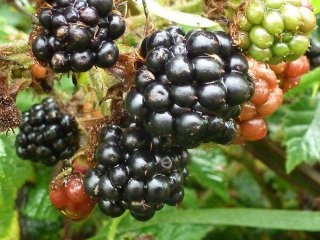Autumn is a wonderful time to be blackberry muncher - you cannot fail to notice bramble bushes hanging heavily with fruit at this time of year.

According to archaeological evidence (seeds found in the stomach of Neolithic Essex man), man has been blackberrying for at least 8,000 years – and that really is no surprise. Last year's cool wet summer delivered a poor autumn harvest, but conditions were good for growth, and so this year plants have been able to take advantage of ideal conditions for flowering, and warm dry conditions to ripen the fruit.
Blackberries are not actually true berries, but aggregate fruits, agglomerations of individual berries known as drupelets. The druplets form in clusters at the end of mature shoots, which die back after 2 or 3 years fruiting. The black berry at the very tip of the stalk is the first to ripen, and the sweetest and fattest of all. A few weeks later, the other fruits near the end ripen. These are less juicy (but just fine for pies and jams). By the end of October the remaining berries have often picked up mildews and bacteria and turned sour or cloying. There is an old lore to discourage the picking of these inferior specimens which says that the Devil runs rampant through the countryside on Michaelmas night (Sep 29th) spitting, stamping and peeing on all remaining fruit – which certainly would account for their diminishing appeal!
 |
 |
 |
Over 320 'microspecies' of bramble have been identified and recorded, with up to an estimated 200 yet to be documented – more info here www.bsbi.org.uk/Rubus_Crib.pdf. Connoisseurs have even detected the subtleties between these varieties – fruiting time, size, texture and taste (hints of plum, grape, apple or lemon – see Richard Mabey's Flora Britannica for more info)
 |
A single cup serving of blackberries contains:
|
And of course, not only are blackberries easy to pick they are easy to eat and it's a joy to think of different ways to consume them. Here is a delicious recipe we have tried to utilise both the blackberry and courgette glut we have at home http://cambridge.cropshare.org.uk/recipes/courgette-and-blackberry-cake/. It has been well and truly approved in an independent taste test, though it is actually a bit more of a pudding. Enjoy!
Click here for information about other plant species found on the Lizard.
{jcomments on}
